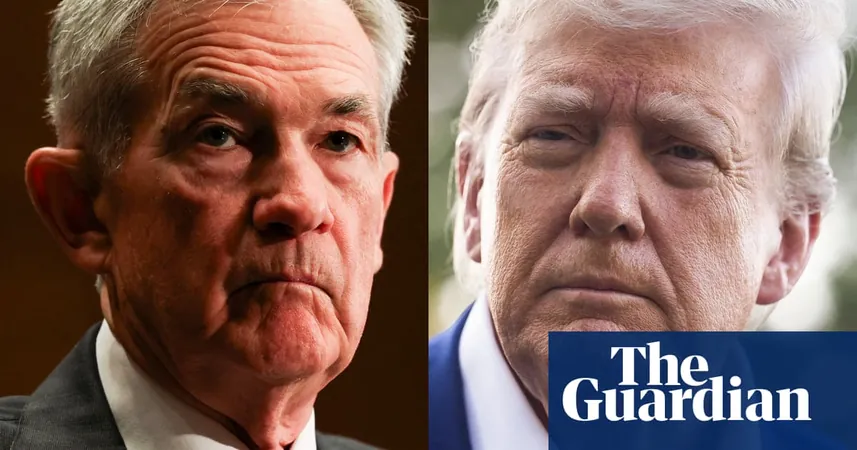
Will Hong Kong Soar as Global Financial Trends Shift?
2025-05-23
Author: Wei
In a striking turn of events in early May, the Hong Kong dollar reached the peak of its trading limits against the U.S. dollar, prompting a swift intervention from the Hong Kong Monetary Authority. To stabilize the currency, the authority infused a whopping HK$129.4 billion (approximately $16.5 billion) into the market, nearly tripling the local banking system's aggregate balance and driving down the Hong Kong Interbank Offered Rate (Hibor). This financial maneuver coincided with CATL, a leading Chinese battery manufacturer, launching a massive HK$35 billion IPO in Hong Kong—the largest in the world since 2023. These developments hint at a rebound in market liquidity and growing investor confidence in Hong Kong, despite a decline in participation from U.S. investors.
As the global financial landscape shifts, the U.S. dollar has seen a dip in 2024—a key factor in a broader "de-dollarization" trend. Many nations are pivoting away from dollar-denominated assets, especially as tariffs increase. This shift is projected to lead to a significant repatriation of funds toward markets in Asia, the Middle East, and the European Union. Hong Kong, known for being one of Asia's most liquid offshore markets, stands primed to exploit this transition.
The current U.S.-China tariff policies have prompted widespread skepticism regarding the reliability of American economic policies, driving up global trade costs, pushing deglobalization, and undermining the U.S. dollar's reserve currency status. As investments begin reallocating, we are likely to see increased volatility in global markets that further stresses the dollar.
On the flip side, the Chinese yuan is gathering strength, buoyed by China's robust manufacturing capabilities and a burgeoning trade surplus. Over the past decade, Chinese institutions and exporters have funneled over $1 trillion into dollar-denominated assets. However, as the dollar weakens, these same investors are being compelled to rethink their asset allocations.
For Hong Kong, a softer dollar presents a chance to enhance its competitive edge against mainland China, easing local financial conditions and stimulating asset price growth. With Hong Kong's currency closely pegged to the U.S. dollar—its primary trading partner being mainland China—fluctuations in the yuan significantly influence Hong Kong's market competitiveness and economic environment. A stronger yuan reduces the effective exchange rate of the Hong Kong dollar, thereby alleviating local monetary conditions.
Hong Kong operates without an independent monetary policy, absorbing economic shocks through variations in prices and property values, which amplifies asset volatility. Enhanced liquidity alongside lower borrowing costs could lead to further surges in asset prices.
Since the 1990s, surplus economies such as China, Japan, OPEC nations, and ASEAN have built significant dollar reserves, with China alone holding a staggering $7.1 trillion goods surplus with the U.S.—38% of its projected 2024 GDP. With the dollar depreciating, these countries are likely to modify their currency holdings, moving away from U.S. dollar assets. Hong Kong appears set to reap the benefits of this capital reallocation, especially as the demand for offshore Chinese assets continues to grow.
Moreover, many Asian financial institutions remain heavily invested in dollar assets, with Japanese banks holding 6% of their assets in foreign currencies and Taiwanese insurers keeping 61.3% overseas. As this capital starts flowing back, Hong Kong is slated to experience an upsurge in asset prices and market activity.
While this de-dollarization process may temporarily intensify volatility within U.S. and Hong Kong assets, the underlying strength of Hong Kong's economy and the inflow of capital should bolster its market resilience. In the first quarter of 2024, Hong Kong's real GDP climbed 3.1% year-on-year, supported by ongoing capital inflows that sustain its market's liquidity.





 Brasil (PT)
Brasil (PT)
 Canada (EN)
Canada (EN)
 Chile (ES)
Chile (ES)
 Česko (CS)
Česko (CS)
 대한민국 (KO)
대한민국 (KO)
 España (ES)
España (ES)
 France (FR)
France (FR)
 Hong Kong (EN)
Hong Kong (EN)
 Italia (IT)
Italia (IT)
 日本 (JA)
日本 (JA)
 Magyarország (HU)
Magyarország (HU)
 Norge (NO)
Norge (NO)
 Polska (PL)
Polska (PL)
 Schweiz (DE)
Schweiz (DE)
 Singapore (EN)
Singapore (EN)
 Sverige (SV)
Sverige (SV)
 Suomi (FI)
Suomi (FI)
 Türkiye (TR)
Türkiye (TR)
 الإمارات العربية المتحدة (AR)
الإمارات العربية المتحدة (AR)